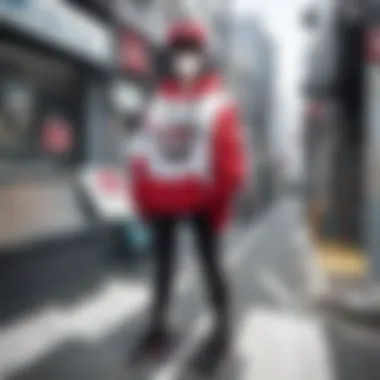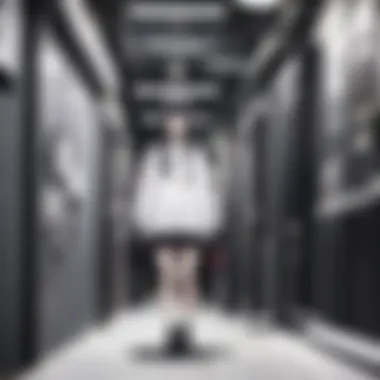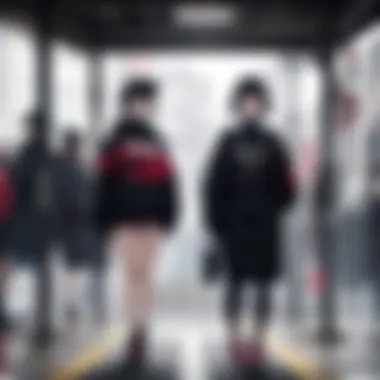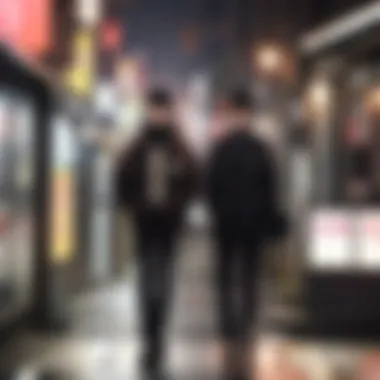Exploring Tokyo's Underground: Culture and Evolution


Intro
Tokyo's underground scene is a multifaceted tapestry, blending history, art, and urban lifestyle. It reflects the city’s vibrant culture and showcases how subcultures can shape a nation's identity. Understanding this scene requires delving into its roots as well as its contemporary expressions.
Tokyosights can often limit one’s perspective, focusing solely on its towering skyscrapers and neon-lit streets. However, the underground movements offer a different lens through which to view this metropolis. This article will uncover the various elements that form the core of Tokyo’s underground, addressing not only the historical context but also its relevance in today’s world.
From the alternative music venues in Shimokitazawa to the art galleries in Ueno, we will explore how the underground scene has influenced popular culture. This exploration includes examining the integration of technology and its impact on both artists and audiences. As we move forward, we will also hear the voices of those who inhabit this world and how they contribute to its evolution. Ultimately, this analysis will serve as an essential resource for enthusiasts and researchers dedicated to understanding one of the most dynamic aspects of Tokyo's cultural landscape.
Understanding the Concept of the Underground
Understanding the underground culture in Tokyo serves as a foundation for analyzing this city's unique social and artistic landscape. The term "underground" encompasses various elements that signify resistance to mainstream society and the exploration of alternative lifestyles. By examining this culture, we gain insight into the motivations and aspirations of those who embrace it. It is crucial to recognize that underground culture thrives on innovation and experimentation, offering a platform for self-expression.
The underground scene includes diverse categories, such as music, fashion, art, and social practices. This rich tapestry creates a microcosm of ideas which can challenge dominant narratives in society. Moreover, engaging with underground culture allows individuals to decode its messages, revealing a complexity often overlooked by the mainstream narrative.
This exploration highlights the power dynamics between the mainstream and the underground, and the influence they have on each other. The insights gleaned from this analysis can foster a deeper appreciation for subcultures and their contributions to the broader societal discourse.
Definition of Underground Culture
Underground culture refers to a movement that exists independently of mainstream social and cultural institutions. It arises from various factors, including disenchantment with traditional forms of expression and a desire for authenticity. In Tokyo, underground culture embodies the spirit of rebellion and the quest for identity.
This culture includes various forms of creative and social expressions:
- Art: Graffiti, street art, and other unconventional artistic practices.
- Music: Genres such as punk, indie, and electronic music that reject commercial trends.
- Fashion: Unique styles that reflect identity and social commentary.
- Social Practices: Gatherings, performances, and exhibitions that challenge norms.
The definition underscores the importance of grassroots movements and their role in shaping the ethos of a community. It creates spaces for dialogue, creativity, and exploration, often leading to significant cultural shifts.
Historical Context of the Tokyo Underground
The historical backdrop of Tokyo's underground culture is rich and varied. Post World War II, the city underwent substantial transformations, impacting individuals' perspectives. A wave of disillusionment followed the devastation of the war, pushing many to seek alternative avenues for expression.
During the 1960s and 1970s, the emergence of countercultural movements gave birth to what is now recognized as Tokyo's underground scene. Influenced by global currents, such as Western punk and avant-garde art movements, Tokyo began to cultivate its unique styles and sounds. Key moments included:
- The rise of independent music scenes, with clubs nurturing local bands.
- The reimagining of street fashion, leading to the formation of distinct styles such as Harajuku fashion.
- A surge in alternative art spaces, promoting experimental and provocative works.
Throughout the ensuing decades, the underground culture in Tokyo has continued to evolve. The impacts of globalization, technology, and societal changes have contributed significantly to its development. Understanding this history allows for deeper insights into the current dynamics and influences existing within Tokyo's underground today.
The Evolution of Tokyo's Underground Scene
The evolution of Tokyo's underground scene is a critical component in understanding the multifaceted nature of the city's culture. This aspect reveals how social, political, and technological changes have shaped the behaviors and ideals of its participants. By examining this evolution, one can appreciate the mechanisms that have contributed to the rise of various subcultures. Each transformative phase offers insights into the motivations of individuals involved in this scene and helps to clarify the intersection between personal identity and collective culture.
From Post-War to the Present
The aftermath of World War II marked a significant turning point for Japan, especially Tokyo. The city faced devastation, but it also became a breeding ground for new ideas and aspiring artists. In this chaotic environment, the seeds for the underground scene began to sprout.


Initial expressions of this underground movement were often found in art and literature, pushing against the mainstream narratives of post-war recovery. Writers like Yukio Mishima and poets such as Shuntaro Tanikawa explored the human condition amid societal rebuilding.
As the decades progressed, subcultures continued to emerge, particularly during the 1960s and 1970s. The rise of youth culture, fueled by economic growth, led to trends in fashion and music, such as the advent of rock and punk. Local venues became important hubs. These spaces fostered performance art and experimental music, which differed from conventional styles.
Today, the underground scene reflects influences from multiple eras, continually adapting and transforming. The use of new media and digital platforms to promote art and music parallels earlier movements. This transition highlights a constant: a desire for authenticity and self-expression in an urban landscape that can sometimes feel homogenized.
Influences from Global Countercultures
The intersection of Tokyo's underground with global countercultures has strengthened its diversity and vibrancy. From the Beat Generation to the British punk movement, influences from outside Japan have played a vital role. Each wave of international style brought fresh perspectives and ideas, resonating with local youth.
For example, the 1980s saw an increased fascination with American punk rock, leading to local bands emulating styles and aesthetics from the West. Similarly, the rise of hip-hop during the 1990s offered new avenues for expression, merging with traditional Japanese influences to create unique sounds and lyrics.
Furthermore, this dynamic exchange has facilitated the growth of subcultures like visual kei, incorporating flamboyant fashion intertwined with music. This blend of diverse global influences underscores the globalized context in which Tokyo's underground thrives.
The ongoing evolution of this scene illustrates that while local identities remain crucial, acknowledgment of global trends is equally important. As Tokyo's underground continues to absorb and transform these influences, it reinforces a sense of community and belonging among the participants.
"The underground is where creativity finds its true voice, often unrestrained by commercial demands or mainstream expectations."
Subcultures within Tokyo’s Underground
Tokyo's underground scene is a rich tapestry woven from diverse subcultures. Each of these subcultures plays a vital role in shaping the identity of the underground as a whole. Understanding these subcultures provides insights into Tokyo's vibrant urban life, social dynamics, and creative expressions. This section delves into significant components such as youth engagement and the fashion landscape, honing in on how these factors contribute to a unique cultural environment.
The Role of Youth Subcultures
Youth subcultures are crucial in driving the evolving landscape of Tokyo's underground. They represent a spirit of experimentation, creativity, and rebellion against traditional norms. Young people often establish new subcultures that reflect their values and identities, paving the way for social transformation.
These subcultures gather to form communities that allow for self-expression. For example, groups such as Harajuku's fashion scene highlights individuality. It showcases how youth creativity manifests through distinctive styles and preferences. Such movements are not just fashion statements; they often carry deeper philosophical meanings, particularly around freedom and identity.
The Intersection of Fashion and Identity
Fashion in Tokyo's underground is more than mere clothing. It serves as a form of identity and expression. By observing the various styles, one can unpack the narratives that accompany them. Each fashion trend tells a story about the individuals embracing it.
Street Fashion Trends
Street fashion trends are an essential aspect of Tokyo's underground identity. These trends evolve rapidly, showcasing a blend of influences from both local and global cultures.
The key characteristic of street fashion is its fluidity. It allows individuals to play with styles, mixing and matching elements to create unique looks. This customization encourages a sense of ownership and individuality, which resonates with many. The downside is that rapid changes in trends can make it hard for voices to stand out. However, this very dynamism keeps the scene alive and engaging.
Influences of Visual Kei
Visual Kei is another powerful force within Tokyo's underground. This musical genre melds flamboyant fashion with rock and punk influences.
The unique feature of Visual Kei lies in its theatricality. Artists often adopt striking, and sometimes androgynous, looks that challenge conventional gender norms. This aesthetic serves as a platform for self-expression for many fans. The challenge comes in balancing creativity with commercialism, as mainstream acceptance can dilute some of the subculture's raw authenticity.


The Kawaii Aesthetic
The Kawaii aesthetic embraces cuteness as a central theme. It expresses innocence, playfulness, and comfort in an often chaotic urban environment.
A notable characteristic is its accessibility. The Kawaii style appeals to various age groups and demographics, making it popular. This appeal offers individuals a sense of community, allowing them to connect with others who share similar interests. However, the challenge arises when the term "kawaii" is commercialized, sometimes stripping it of its original intentions and meanings.
These subcultures not only contribute to personal identity but also create a chaotic yet beautiful landscape of individuality and expression.
Art and Expression in the Underground
Art and expression play crucial roles in Tokyo's underground scene. This vibrant sector of creativity acts as a mirror reflecting social issues, cultural shifts, and individual sentiments. Through various art forms, underground culture provides platforms for voices that are often marginalized or misunderstood by mainstream society. The scope of art varies widely, encompassing everything from street art to performance, each contributing uniquely to the overall landscape of underground Tokyo.
Visual Art Scene
Graffiti and Street Art
Graffiti and street art are among the most dynamic aspects of the visual art scene in Tokyo. These art forms often serve as a direct form of expression, allowing artists to communicate messages quickly and effectively. One key characteristic of graffiti is its accessibility; it is available to anyone with a spray can and a creative idea. This makes it an appealing medium for many emerging artists wishing to make their mark in the urban environment.
Furthermore, graffiti and street art often address social issues and inspire dialogues about politics, identity, and community. The unique feature of this type of art is its transient nature—pieces may appear overnight and disappear just as quickly due to city regulations or the harsh weather. This aspect can be both an advantage and a disadvantage; it keeps the art form fresh but can leave artists feeling frustrated when their work is removed before gaining recognition.
Gallery Spaces and Pop-Up Exhibitions
Gallery spaces and pop-up exhibitions further enrich Tokyo's underground art scene. These venues provide professional settings for artists to present their work, fostering engagement between the creator and the audience. Pop-up exhibitions, in particular, are known for their ephemeral quality; they appear suddenly and are often curated around specific themes or artists. This allows for diverse artistic expressions to be showcased without the long-term commitment of traditional galleries.
A notable feature of these spaces is the inclusion of a variety of media, ranging from photography to interactive installations. This diversity attracts a broader audience and stimulates discussions about the art presented. However, one downside is that the short timeframes can limit the exposure artists receive, as the public may not be aware of the events until they are already over.
Music and Performance Art
Underground Music Venues
Underground music venues are essential in promoting the diverse sounds emerging from Tokyo's underground scene. They provide intimate spaces for performances that are often not supported by larger, commercial venues. A critical characteristic of these venues is their focus on diversity; they often host a range of genres, such as punk, metal, and experimental music. This diversity reflects the eclectic tastes of the underground community and facilitates the exploration of new music.
The unique feature of these venues is their role as community hubs; they often cultivate loyal followings and encourage collaboration among artists. The downside, however, is that these spaces can struggle financially, making them vulnerable to closure or relocation. This impermanence can create challenges for artists seeking stable platforms to showcase their work.
DIY Music Culture
DIY music culture is a cornerstone of Tokyo's underground scene, highlighting self-sufficiency and grassroots initiatives. This approach allows artists to create and distribute their work without relying on commercial labels or mainstream channels. A key characteristic of DIY culture is its emphasis on authenticity; musicians take control over their artistic vision and management.
Moreover, this culture enables a strong sense of community among artists and supporters. Unique features include independent record labels, self-organized shows, and online platforms where artists can share their work directly with fans. While this model fosters innovation and creativity, the challenges include limited access to resources and financial instability, making it difficult for some artists to gain wider recognition.
"The underground scene thrives on collaboration and mutual support, allowing emerging artists to blossom away from commercial pressures."
The Technological Influence on Urban Underground


In recent years, technology has played a crucial role in shaping urban underground cultures in Tokyo. This influence manifests in various forms, significantly impacting how artists, musicians, and enthusiasts interact, promote, and disseminate their work. Understanding this influence is essential, as it not only reflects the evolution of Tokyo's underground scene but also highlights how traditional boundaries are transcended through digital advancements. Two key areas where technology is most prominent are digital art and the use of social media for promotion.
Digital Art and the Underground
Digital art has increasingly become an integral part of Tokyo's underground scene. Artists are utilizing digital tools to create dynamic works that push the limits of traditional mediums. Various styles, including digital painting, 3D modeling, and animation, have found a prominent place within this subculture. The accessibility of software and platforms allows aspiring artists to express themselves in innovative ways. This has led to a proliferation of art showcasing not just personal visions but also reflections of broader cultural themes.
A significant benefit of digital art is its capacity for rapid distribution. Artists can share their work through platforms like social media and various online galleries, enabling them to reach a global audience. This immediate feedback loop fosters community interaction and collaboration. However, alongside these advantages, digital art also raises questions about authenticity and the commodification of art in virtual spaces. Despite these challenges, digital art remains a vibrant facet of the underground scene.
Social Media’s Role in Promotion
Social media serves as a powerful tool for promoting and elevating Tokyo's underground culture. Platforms such as Instagram, Twitter, and Facebook enable artists and performers to broadcast their work instantly. Through these channels, individuals can share their thoughts, creations, and upcoming events, ensuring that the underground scene remains visible and relevant in popular culture.
Engagement on social media fosters a sense of community among fans and creators. They can connect over shared interests, facilitating collaboration and discussion. Hashtags play an essential role in this ecosystem, allowing users to easily find and engage with specific themes and movements.
However, while social media presents numerous opportunities, it also comes with challenges. The oversaturation of content can make it difficult for individual creators to stand out. Moreover, concerns about privacy and audience reception often influence how artists present their work online.
In essence, the intersection of technology and urban underground culture in Tokyo is a dynamic space, creating both opportunities and complexities for artists and audiences alike.
Social and Political Dimensions
Understanding the social and political dimensions of Tokyo's underground scene is crucial for appreciating its depth. This section explores how this vibrant culture engages with various societal issues, including identity, expression, and resistance. It emphasizes the way art, music, and fashion within the underground can reflect broader socio-political contexts. This context is particularly relevant in Tokyo, where traditional norms often collide with progressive ideals, creating a unique space for dialogue.
Resistance and Rebellion
The underground scene in Tokyo serves as a significant venue for resistance and rebellion. It provides a platform for individuals who feel marginalized by mainstream culture. Artists, musicians, and creatives often use their work as a means of expressing dissent against societal expectations and governmental policies. This has roots in historical movements, where subcultures have resisted oppressive structures through various forms of creative expression.
In this dynamic environment, underground artists often challenge conventions. They tackle issues such as consumerism, social conformity, and political repression. The music scene, including punk and experimental genres, reflects rebellion through its aggressive lyrics and unpolished sound. Visual art, particularly graffiti, becomes a potent symbol of resistance. It emerges on the streets as a commentary on urban life, illuminating the struggles and aspirations of those involved.
Societal Perceptions and Misunderstandings
The societal perception of Tokyo's underground culture is often marked by misunderstanding and stigma. Many outside this world view these subcultures as merely odd or deviant. This perspective overlooks the complex narratives that shape underground communities. It is essential to recognize that the underground is not just about fashion or music trends; it embodies a rich tapestry of lived experience, community, and individual expression.
These perceptions can lead to a disconnect between mainstream society and the underground. This gap often results in marginalization, which can further drive the community underground. However, there is also a growing recognition of the positive contributions these subcultures make. The influence of underground culture is seen in mainstream fashion and arts, leading to collaborations that push the boundaries of traditional societal norms. Understanding these dynamics is crucial for appreciating the importance of the underground in the broader cultural landscape of Tokyo.
Future Prospects of Tokyo's Underground
The future of Tokyo's underground scene is a compelling topic, especially as it reflects the continual evolution of culture in response to external influences. The underground community has always adapted to societal shifts, technological advancements, and global trends. Understanding its future is essential for enthusiasts and researchers alike, as it may influence mainstream culture in Japan and beyond. This section will explore how the underground can navigate challenges while maintaining its unique identity.
Adapting to Changing Times
The adaptability of Tokyo’s underground culture reveals its resilience and creativity. As society shifts, the underground scene modifies its expressions to resonate with contemporary issues. For example, the rise of digital platforms has led to new forms of art and music, allowing artists to reach broader audiences. This transition highlights how technology influences creativity. Artists are no longer confined to physical venues; they can share their works online, creating a global dialogue around their art.
Moreover, the ongoing challenges posed by urbanization and commercialization pressure the scene to evolve. Venues may close, but new ones emerge, often in unexpected locations. This phenomenon shows the underground’s ability to find space in densely populated areas, whether it's through pop-up art exhibits or underground music events. Social movements, such as environmentalism and gender equality, also find their voice in this culture, showcasing a potent blend of activism and expression.
Sustaining the Authenticity of the Scene
While adaptability is necessary, maintaining authenticity in a changing environment presents challenges. The core of Tokyo's underground lies in its grassroots nature; the community thrives on independence, creativity, and inclusivity. To sustain this authenticity, members of the underground scene must remain vigilant against commercialization.
Protecting unique subcultures means fostering collaboration rather than competition. Local artists should prioritize sharing resources and spaces to support each other. Events that celebrate the underground community can help counteract the tendency to commodify art and expression.







